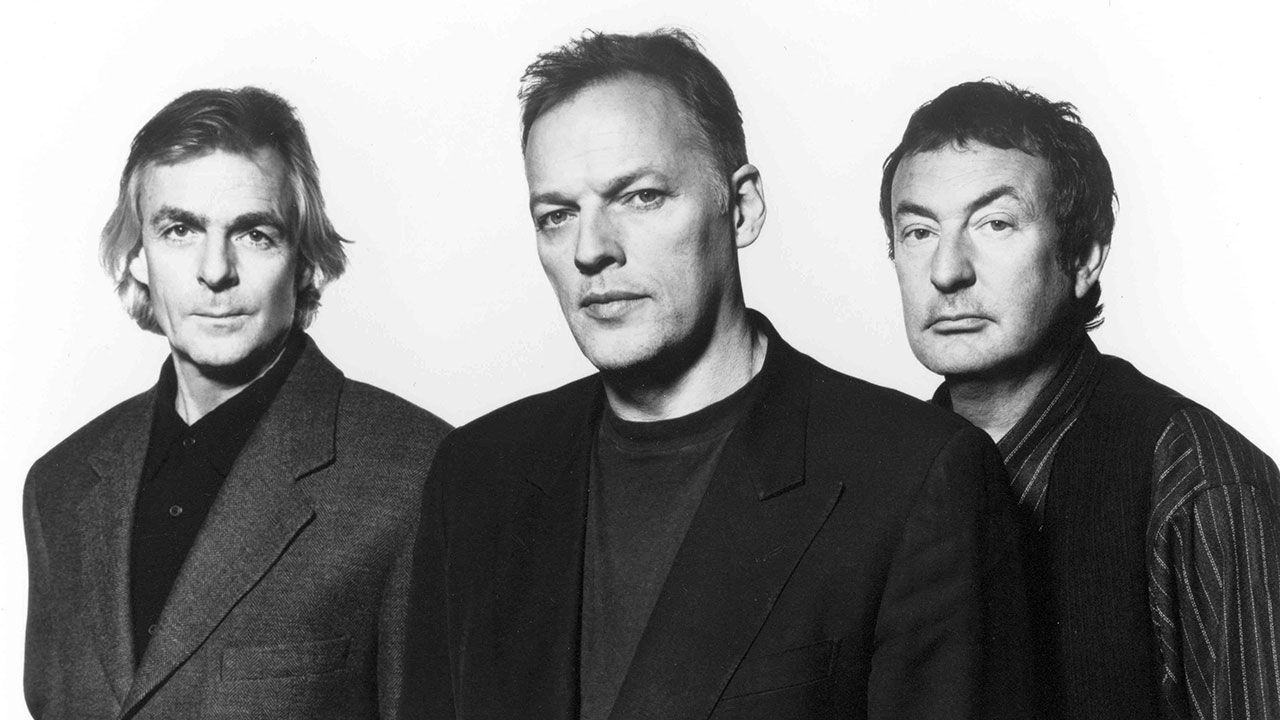In the middle of legal disputes over their name, Pink Floyd created a personal and emotionally exposed album. The Division Bell defiantly went against the Britpop zeitgeist to top the charts on both sides of the Atlantic. Prog explored its history in 2014.
"Why is that bloke singing like Syd?” asked Rick Wright. It was May 1994, and Pink Floyd’s keyboard player had just heard Blur’s new album Parklife. Floyd were on tour in America and had gathered in guitarist David Gilmour’s hotel suite to listen to the album that had just supplanted their latest, The Division Bell, at the No.1 spot.
Wright might have been concerned that Damon Albarn sounded like his ex-bandmate Syd Barrett, but his was the only dissenting voice. “We wanted to hear what all the fuss was about,” bassist Guy Pratt said. “Most of us thought Parklife was very good.”
Pink Floyd could afford to be gracious in defeat. The Division Bell, released in March 1994, became the band’s first album since 1975’s Wish You Were Here to reach No.1 in both the UK and US. Their 14th studio release also went multi-platinum and turned out to be a lone victory for prog rock in the boom years of Blur-style Britpop and dance music.
The Division Bell should be remembered for its music rather than the intra-band bickering that had blighted the previous nine years.
In October 1985, three years after Floyd’s The Final Cut, founder member/bass guitarist Roger Waters took out a High Court application to try to prevent the band name being used again. Weeks later he informed the group’s record company that he was leaving the band, and that the group were no more.
Unfortunately for Waters, Gilmour had no intention of laying Floyd to rest. “Dave absolutely saw red, and finally got it together to go back to work,” wrote drummer Nick Mason in his memoir, Inside Out. A year later, the Waters-less Floyd made their debut with A Momentary Lapse Of Reason.
Wright, who’d left under duress in 1979, had returned midway through the sessions, but wasn’t made a full-time member again. Instead, his name topped a list of 16 session musicians deployed to help bring the band back from the dead. Gilmour worked briefly with several outside songwriters, and the process was frequently interrupted by calls from lawyers tasked with defending his decision to continue. Waters even tried to stop the new Floyd from touring – but failed.
We had what we called ‘the big listen,’ where everyone voted on each piece of music
David Gilmour
He went on to describe A Momentary Lapse as “a fair forgery,” but it still reached No.3 in Britain and America, and was promoted with a tour that turned Floyd into the second highest grossing act of 1987.
“I didn’t think it was the best Pink Floyd album ever made,” Gilmour admitted. But it proved that Floyd could still be a commercial success without Waters, the man who’d devised the concepts for The Dark Side Of The Moon, Wish You Were Here and The Wall.
The first steps towards making The Division Bell began in January 1993 with Gilmour, Mason and Wright jamming in their Britannia Row Studios in North London. Before long, Pratt, who’d played on the Momentary Lapse tour, joined them. It was a dream come true for the bassist who, as a teenager, had watched his colleagues play The Wall at Earls Court. “It was thrilling to know you were playing on a Pink Floyd record,” he said Pratt, recalling that Gilmour gently instructed him to lose “90 per cent of the notes I was playing”.
By spring, Gilmour had moved the operation to his houseboat-cum-studio, Astoria, on the Thames, and he brought in The Wall and Momentary Lapse co-producer Bob Ezrin. Having amassed around 65 of what Mason described as “riffs, patterns and musical doodles,” Gilmour reported that "we had what we called ‘the big listen,’ where everyone voted on each piece of music.”
Ideas were merged or discarded; but so much material was left over that the band briefly considered, then rejected, the idea of releasing some of it on a separate album, including a set they dubbed The Big Spliff – which was, Mason explained, “the kind of ambient mood music being adopted by bands like The Orb.”
The voting system was abandoned when the others discovered that Wright was awarding his ideas the highest possible score, and everybody else’s the lowest. Part of the problem was that he wasn’t a full band member: “It came very close to a point where I wasn’t going to do the album, because I didn’t feel that what we’d agreed was fair,” he said. Soon he was fully reinstated, and scored credits on four of the album’s 11 tracks.
High Hopes pulled the whole album together. It also gave us an idea around which to hang some of the broader concepts
bob Ezrin
Shortly before the summer, Floyd – joined by Pratt and fellow touring members Tim Renwick Gary Wallis and Jon Carin – entered Olympic Studios in Barnes, West London, and recorded a handful of new songs. They later reconvened on the Astoria and began developing those tracks further. But Gilmour now faced the hurdle of writing lyrics; and unlike Waters, he wasn’t a confident lyricist. Ex-Slapp Happy songwriter Anthony Moore – who’d co-written on A Momentary Lapse – and former Dream Academy singer-songwriter Nick Laird-Clowes would both contribute to The Division Bell. But Gilmour’s then girlfriend, journalist and author Polly Samson, would end up co-writing the lion’s share of the words.
“I started writing things and looking to her for an opinion; and gradually, as a writer herself and an intelligent person, she started putting her oar in, and I encouraged her,” explained Gilmour, who’d spend the day working on the music on the Astoria before going home to write with his soon-to-be wife. “There was,” he said, “a whole invisible side to the process.”
Not everyone was comfortable with the situation. “It wasn’t easy at first,” Ezrin admitted. “It put a strain on the boys’ club, and it was almost clichéd to have this new woman coming in and then get involved in the career. But whatever David was thinking at the time, she helped him find a way to say it.”
Between them, the couple wrote the album’s strongest song, High Hopes. “It pulled the whole album together,” said Ezrin. “It also gave us an idea around which to hang some of the broader concepts.” Partly inspired by Gilmour’s childhood and adolescence in Cambridge, its beautiful lap steel guitar solo evoked Shine On You Crazy Diamond, while composer Michael Kamen’s orchestral arrangement flashed back to the strings and woodwind he’d used on Comfortably Numb.
In the meantime, Floyd dragged some of their vintage keyboards out of storage and sampled their sounds for Take It Back and Marooned. Wright was delighted: “My influence can be heard on tracks like Marooned. Those were the kind of things that I gave the Floyd in the past – it was good that they were now getting used again.”
In fact, the whole album was full of familiar motifs. Dark Side and Wish You Were Here saxophonist Dick Parry returned to the fold. So too did Dark Side mixing supervisor Chris Thomas, who helped oversee the final mix instead of Ezrin. “That was disappointing,” understated the producer.
It’s more of a wish that all problems can be solved through discussion, rather than a belief
David Gilmour
High Hopes’ themes of nostalgia and reflection were reprised in the Gilmour, Samson and Laird-Clowes composition Poles Apart. Its first verse was inspired by Barrett; its second by Waters. What Ezrin called “the broader concept” of The Division Bell was communication and the difficulties thereof: between friends, wives and lovers, and former bandmates.
The clues were there in titles such as Lost For Words and Keep Talking, the last of which sampled scientist Stephen Hawking’s voice. “It’s more of a wish that all problems can be solved through discussion, rather than a belief,” said Gilmour, who was well aware of the irony considering Floyd’s poor track record in communicating with each other.
However, The Division Bell also seemed to have a subtext: rebirth. On Wearing The Inside Out, Wright cast himself as a man venturing back into the world after years of isolation. “There’s a lot of emotional honesty there,” said Ezrin. “Fans pick up on a sad and vulnerable side of Rick.”
Wright wasn’t the only one being emotionally honest. Gilmour talked about ‘killing the past’ on Coming Back To Life. Many took this as a reference to embracing his relationship with Samson and rejecting the hedonistic lifestyle he’d been enjoying for the previous few years.
Revisiting The Division Bell now, the angst and tension remains clear. On What Do You Want From Me, supposedly inspired by good old fashioned marital strife, Gilmour sounds fired up and frustrated as he dishes out some heavy blues guitar. Play it alongside 2006’s charming if very contented-sounding solo album On An Island, and you can hear the difference.
The album was complete by the new year, and the band began casting around for titles. Nick Mason favoured ‘Down To Earth’; others preferred ‘Pow-Wow’. In the end band friend and The Hitchhiker’s Guide To The Galaxy author Douglas Adams, spotted the words ‘the division bell’ in the lyrics to High Hopes, and suggested that instead.
I wish it wasn’t the last Pink Floyd album. But I wouldn’t hold my breath
Bob Ezrin
Although the record suffers from what Pratt calls some “80s production hangovers,” it’s compensated for by Gilmour’s sense of tension and urgency, along with Wright’s welcome presence. Unlike Momentary Lapse, The Division Bell feels like a group effort; and Gilmour was soon telling interviewers that he thought it was the most Pink Floyd-sounding album since Wish You Were Here. Everything from those spaced-out keyboards to the languid guitar solos and Storm Thorgerson’s grandiose cover art compounded his theory.
Waters called it “an awful record,” and Melody Maker likened it to “chewing on a bucket of gravel” – but Floyd’s fanbase disagreed and the album soon topped the charts in 10 countries. Naturally, you can’t help wondering what a follow-up might have sounded like. Bob Ezrin feels the same. “I wish it wasn’t the last Pink Floyd album,” he said. “But I wouldn’t hold my breath.”


